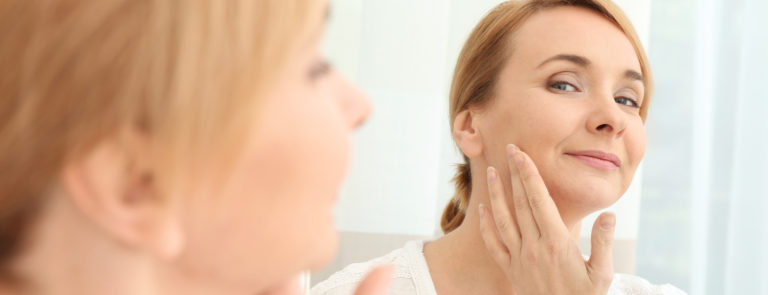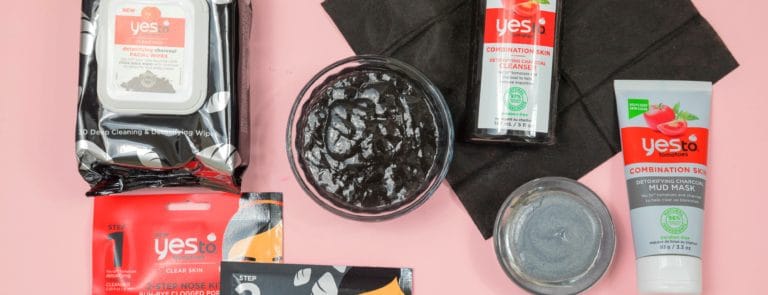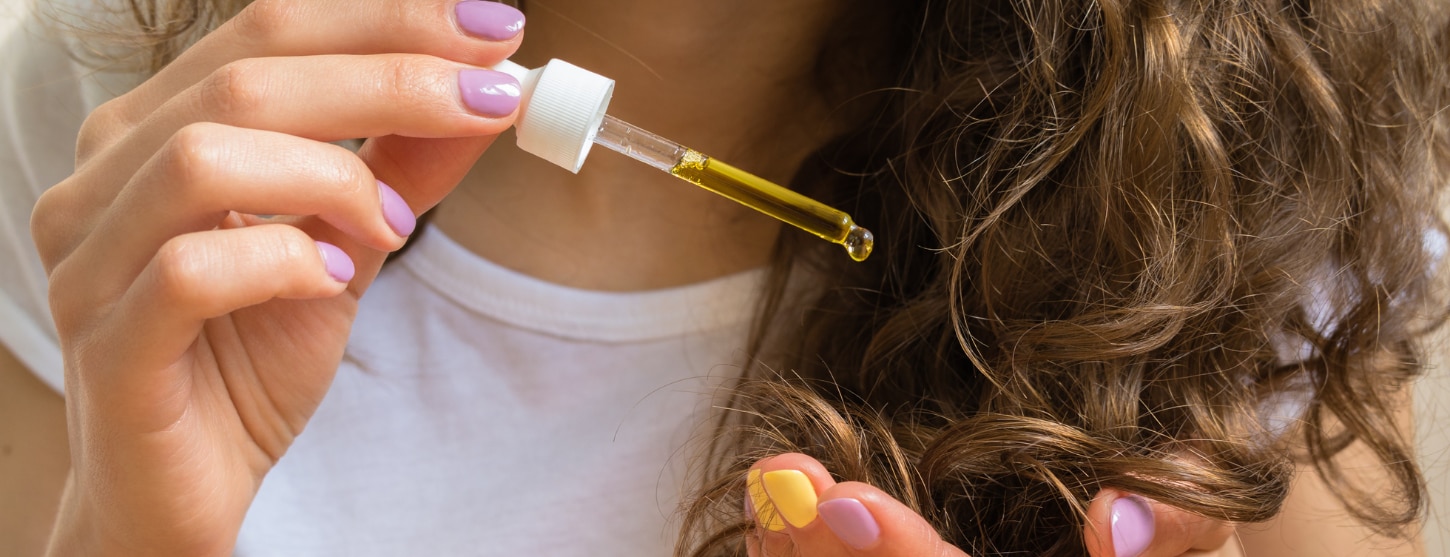15% off €35 OR 20% off €45
Code:CHOOSE
9 ways to manage clogged pores & congested skin

Blocked pores are a major skincare bugbear – leading to blackheads, whiteheads and pimples. Learn what causes them – and how to tackle them for good.
Summary
1What are pores?
You probably know that those tiny pin-prick holes dotted all over your body are your pores. Pores are found in the epidermis, but the follicles...
2Why do our pores become blocked?
The following factors can all lead to blocked pores and congested skin: Insufficient cleansing A good cleansing routine is key for preventing block...
3What is non-comedogenic makeup?
‘Comedogenic’ means pore-clogging. Non-comedogenic products are ones which don’t contain ingredients known to clog pores. Comedogenic ingredients...
Pores play a vital function in our skin’s health. But sometimes they become blocked, leading to unhappy, congested skin.
Luckily, managing blocked pores is simple. You just need a little skincare know-how.
Here we’ll tell you what your pores are, what causes them to become blocked, and what you can do about it.

Anatomy of the skin
The skin is made up of three main layers – the dermis, the epidermis and the subcutaneous layer (also called the hypodermis).1
- The epidermis
This is the top layer of skin – the one you can see. Your epidermis is made up largely of skin cells, which renew and shed every few weeks. The epidermis is also home to your pores. Hair, sweat and oil (which are produced in the skin’s deeper layers) are released via your pores and through the surface of the skin.
The epidermis is the body’s first defence against the world. It’s also where skin concerns like pigmentation, fine lines and open pores will show up first.
- The dermis
Located underneath the epidermis, the dermis is the thickest skin layer. It’s made up of connective tissue, collagen, hair follicles, sweat and oil glands and nerve endings.
- The subcutaneous layer (hypodermis)
The deepest skin layer, the hypodermis contains fat and connective tissue, as well as some hair follicles, glands and nerve endings.
What are pores?
You probably know that those tiny pin-prick holes dotted all over your body are your pores. Pores are found in the epidermis, but the follicles and glands which are linked up to the pores begin deeper inside the skin.
- Secreting sweat
This helps regulate your body temperature and stop us from overheating.2
- Secreting oil
Your body’s natural oil – sebum – is secreted through the pores to moisturise the top layer of your skin (the epidermis) and keep it supple.3
- Hair follicle openings
Deep inside each pore is a hair follicle containing a tiny hair. On some areas of the skin – such as the nose – you can’t see the hairs as they’re so miniscule. In other areas – like the arm – the hair is more visible.

What is congested skin?
The term ‘congested skin’ refers to skin which is dull, blemished and uneven in texture.
Congested skin happens when the dead skin cells which are being constantly shed by the epidermis aren’t effectively removed and sloughed away by thorough daily cleansing. As a result, dead skin cells collect inside the pores along with dirt, sweat, sebum and bacteria.
What happens when our pores become clogged?
The dirt, sweat and oil inside a clogged pore gradually hardens over time and can make the pore larger as a result.4
Clogged pores become blackheads and whiteheads, as well as leading to uneven skin tone, bumps, ingrown hairs and spots.
Summary
- Our skin has three main layers – the epidermis, the dermis and the subcutaneous layer (hypodermis)
- Pores secrete sweat and sebum (natural skin oil)
- Pores can become clogged with dirt, oil, bacteria, sweat and dead skin cells
Why do our pores become blocked?
The following factors can all lead to blocked pores and congested skin:
A good cleansing routine is key for preventing blocked pores from forming.
We shed our entire outer layer of skin every 2 – 4 weeks and we’re shedding skin 24 hours a day!5 This is why a thorough daily cleanse can help stop these microscopic cells from entering our pores and clogging them.
If you never exfoliate your skin, you should start.
Exfoliating sloughs the top layer of dead skin cells from the epidermis before they have a chance to settle into our pores.
Exfoliating isn’t just for the face – your body needs a good scrub too to prevent clogged pores which can lead to issues such as keratosis pilaris and pimples on the legs and buttocks.
Handpicked content: How to get rid of dead skin
Exercise is amazing – and it holds many skin benefits, too.
However, letting sweat dry on your skin after a workout can contribute to blocked pores. Further, the bacteria in sweat can lead to acne if not promptly washed away.6
If you’re after clear skin, you should know that sleeping in makeup is a huge no-no.
Overnight, skin cells continue to shed at a rapid rate, and with a layer of makeup on the skin, these cells have nowhere to go except for back into the pores.7
Further, the makeup itself may find its way deep inside your pores as you sleep, leading to pores suffocated under layers of shed skin and cosmetics which may not be easily washed away.
Blocked pores are often caused or exacerbated by oil glands which produce too much sebum. If not controlled, this oil can gather inside pores, overloading and enlarging them.8
Did you know that people who frequently use mobile phones can experience congested skin where the phone screen makes contact with their face? This is because of the dirt and oil on the device are rubbed onto the skin, clogging the pores in the process.9
Touching your face transfers dirt, oil, bacteria, grease and all manner of microscopic particles directly onto your epidermis. These pore-blocking substances can lead to spot breakouts and blemishes.
The word ‘comedone’ means a blocked pore. A comedone can be open – such as the case with blackheads, or closed – such as with whiteheads.
Some skin products contain pore-clogging ingredients. This includes some makeup, sunscreens and moisturisers – so be aware of what’s in your cosmetics.10
Handpicked content: What does non-comedogenic mean?
Pollutants in the environment – for example cigarette smoke, fuel smoke and traffic fumes – directly accumulate on the skin.11 This is bad news for pores, as these microscopic particles can become trapped inside pores and lead to congestion.
How to clean pores
1. Clogged pores on face
It's common for the pores on your face to become blocked.
Start by cleansing twice daily with a foaming cleanser.
Look for ingredients like salicylic acid and lactic acid, which are gentle exfoliants that help sweep away any dead cells clinging to your epidermis.12
You shouldn’t cleanse your skin more than twice daily. Over-cleansing strips the skin of sebum and can actually encourage your oil glands to overcompensate – producing more sebum in an attempt to keep itself supple.13
Follow with a light moisturiser.

2. Clogged pores on nose
The nose is a hotspot for blocked pores. This is because nose pores are larger than those elsewhere on the face, thanks to larger oil glands beneath.
Pore strips are one option to clear clogged nose pores. These little strips adhere to your skin when dampened, clinging to the skin and taking with them the contents of blocked pores upon removal.
3. Clogged pores on breasts
It’s not just our faces which have oil-producing glands - they're all over our bodies.
With the exception of the palms of our hands and soles of our feet, these oil-producing glands are everywhere.14 The upper chest has a high concentration of oil glands, which is why acne is common there.15
Tight clothing which doesn’t let pores breathe can cause blocked pores, so if you wear a bra - check it’s the right size.
Be sure to wash bras regularly, as they can hold onto lots of sweat and bacteria from the close contact with our bodies.
A cotton bra might be the best choice, as cotton helps absorb sweat better than synthetic fibres.16
4. Clogged pores on chin
The chin is another hotspot for clogged and enlarged pores.
Try an exfoliating pad containing salicylic acid or glycolic acid – both hydroxy acids which can safely remove dulling dead cells and help clear out blocked pores.17
5. Clogged pores on legs
Although the oil glands on our bodies are smaller and less concentrated than those on our faces, they are still prone to clogging.18
Clogged pores on the legs are caused by the same thing as clogged pores on the face – a build up of dirt, sebum and dead skin cells inside the pore.
The best approach is to give your legs a through exfoliation with a dry brush, shower puff or bath sponge every day before your bath or shower.
6. Clogged pores on cheeks
Pores on the cheeks aren’t as large as those on our nose and chin, but they can still become clogged and enlarged in size.
As well as a foaming cleanse twice daily, try a gentle physical exfoliator such as a konjac sponge or mechanical exfoliating brush.
Look for one with the gentlest bristle head to lift the clogs from your pores without damaging the skin.

7. Clogged pores on back
Skin on the upper back has lots of oil glands – which is why it’s a hotspot for blocked pores.19
The most effective way to address blocked pores here is to use a physical exfoliator in the form of a loofah, brush or exfoliating strap every time you take a shower or bath.
This helps clear debris from your pores and helps prevent spots from forming.
8. Clogged pores under arms
Blocked armpit pores are most often the result of a build-up of sweat and deodorant which can cause inflammation of the pores, known as folliculitis.
Remember, your armpits are home to most of your body’s sweat glands, making blockages likely.
Try a gentle exfoliation with a salicylic acid cleanser and change your deodorant to a non-comedogenic one.
9. Clogged pores on scalp
Just like anywhere else on the body, the pores on the scalp can get clogged. This can be down to sweat, sebum, skin flakes or build-up of hair products.
To help unclog them, use an anti-dandruff or clarifying shampoo to rid your scalp of product build-up and flakes, then exfoliate your scalp with a scalp scrub or silicone shampoo brush.
Summary
- Insufficient cleansing, sleeping in makeup and not showering after exercise can lead to blocked pores
- To tackle blocked pores on the face, use a foaming cleanser and exfoliate 1 – 3 times per week with a salicylic acid product
- Nose strips, konjac sponges and mechanical cleansing brushes can help keep facial pores clear, but don’t over-cleanse as this can make oil production worse

What is non-comedogenic makeup?
‘Comedogenic’ means pore-clogging. Non-comedogenic products are ones which don’t contain ingredients known to clog pores.20
Comedogenic ingredients are bad news for people with oily or acne-prone skin, as they increase the likelihood of breakouts and congestion.
Those with normal skin may also want to avoid comedogenic skin products to avoid clogging pores.
Does Vaseline clog pores?
Petroleum jellies contain paraffin – a mineral oil.
Mineral oils are a controversial topic in the world of skincare, with many people believing they are comedogenic and encourage clogging of the pores.
This idea comes from a 1989 study which found that mineral oil caused clogging in the pores of a rabbit’s ear.21,22
What people didn’t consider was that rabbit and human skin is not the same!
Since then, studies on human skin have shown that despite their thick, greasy texture, mineral oil isn’t comedogenic and doesn’t clog pores.23
Can you squeeze clogged pores?
You can technically squeeze clogged pores, although it’s highly recommended that you don’t.
Squeezing pores may be satisfying, but you’ll run the risk of forcing the contents of the pore further down into the skin, making the problem worse. What's more, there is also a risk of infection from spreading bacteria, as well as scarring from damaging the skin as you squeeze.
If they’re really bothering you, see a professional dermatologist for a safe extraction – but don’t expect to come home with each pore squeaky clean.
Some sebum and sebaceous filaments are normal and are simply a sign of healthy, functioning skin.
Summary
- Non-comedogenic products won’t block your pores, so choose these in your skin and body care
- Vaseline is an effective occlusive moisturiser and doesn’t block pores, but using a lighter moisturiser might be more suitable
- Never squeeze blocked pores – it will make the problem worse
- https://www.ncbi.nlm.nih.gov/books/NBK470464/
- https://www.britannica.com/video/22419/Secretion-sweat-glands-skin
- https://www.sciencedirect.com/topics/medicine-and-dentistry/sebaceous-gland/
- https://www.ncbi.nlm.nih.gov/pmc/articles/PMC5605215/
- https://www.acs.org/content/acs/en/pressroom/newsreleases/2011/
- https://www.aad.org/public/diseases/acne/causes/workouts
- https://www.the-dermatologist.com/content/night-skin
- https://www.ncbi.nlm.nih.gov/pmc/articles/PMC5605215/
- https://onlinelibrary.wiley.com/doi/10.1111/ced.14360
- https://dermnetnz.org/topics/comedonal-acne/
- https://www.ncbi.nlm.nih.gov/pmc/articles/PMC6766865/#jdv15583-bib-0034
- https://www.ncbi.nlm.nih.gov/pmc/articles/PMC6017965/
- https://practicaldermatology.com/articles/2020-apr/the-effect-of-cleansers-on-the-skin-microbiome
- https://www.ncbi.nlm.nih.gov/pmc/articles/PMC3051853/
- https://www.ncbi.nlm.nih.gov/pmc/articles/PMC5605215/
- https://www.ncbi.nlm.nih.gov/pmc/articles/PMC4249026/
- https://www.ncbi.nlm.nih.gov/pmc/articles/PMC6017965/
- https://www.ncbi.nlm.nih.gov/pmc/articles/PMC3051853/
- https://www.ncbi.nlm.nih.gov/pmc/articles/PMC3051853/
- https://www.dictionary.com/browse/comedogenic
- https://pubmed.ncbi.nlm.nih.gov/2138094/
- https://insolitbeauty.com/documentacion/Comedogenicidad/
- https://onlinelibrary.wiley.com/doi/full/10.1111/j.1468-2494.2012.00752.x
This article provides informational advice and is not a substitute for medical care. Curated by experts for accuracy, we take great care to ensure the information is up-to-date and relevant. However, you should always consult your GP or healthcare professional before using supplements or alternative products, particularly if you have medical conditions or are under supervision.



